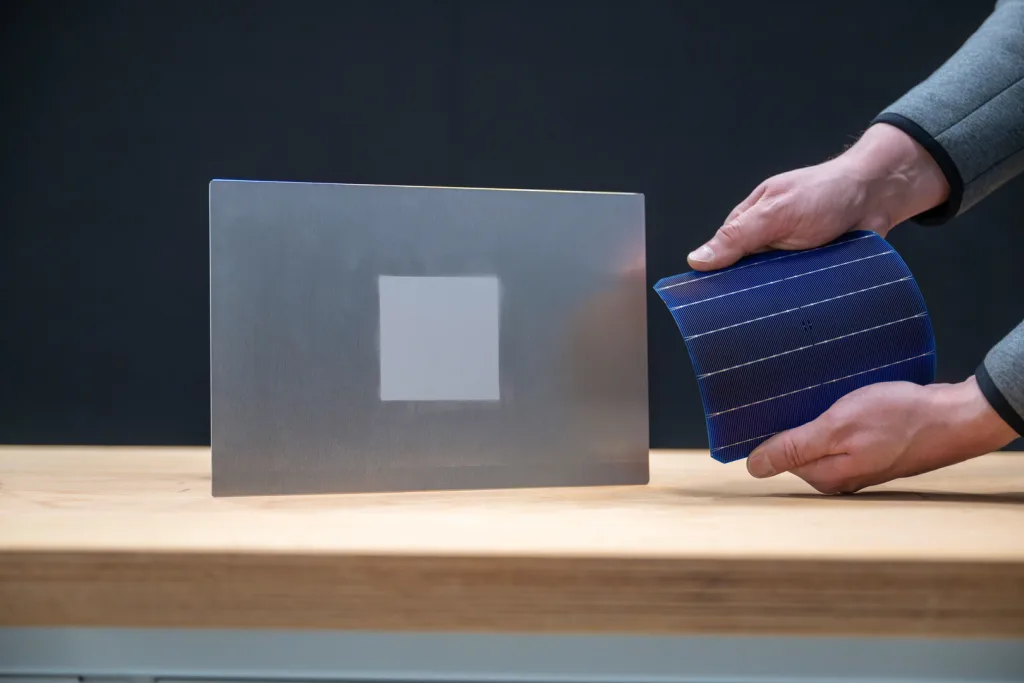In the future, your electric vehicle could be covered in solar panels—not only on the roof, but all over the exterior of the car—thanks to a special paint coating. Whether driving or parked, that solar paint could harvest energy from the sun, feeding it right into the EV’s battery. While it may sound like something from a sci-fi book, researchers at Mercedes-Benz are already working to make it a reality.
“We’re producing hundreds of cars a day, and this is quite a lot of surface. So why don’t [we] use that surface to harvest sun energy?” says Jochen Schmid, senior manager of Future Electric Drive, a research and development division within the automaker that explores early-stage EV technologies.

The photovoltaic material Mercedes has been researching is like a paste that can be applied to a car’s exterior. The coating is just 5 micrometers thin (the average human hair is about 100 micrometers), and weighs 50 grams per square meter. On an average midsize SUV, the paste, which Mercedes is also calling a solar paint, would take up about 118 square feet, producing enough energy to travel up to 7,456 miles per year. That’s under “ideal conditions,” the car maker notes; exactly how much energy this would actually harvest depends on the strength of the sun, and how much shade there is.
Because the solar paint is flexible, it can fit around curves like fenders. That provides more opportunities for solar power than glass solar panels that can’t bend, and so can only be affixed to a car’s roof or hood. The solar paint is part of a multi-step coating that includes the conductive material, insulation, the solar-active material, and then a top coating to provide color (that all together makes up the 5 microns).
That top layer wouldn’t be a standard auto paint since it doesn’t have pigment in it. Instead, that layer would look more like a “butterfly’s wing,” Schmid says, and would be a highly-translucent material filled with nanoparticles that reflect wavelengths from the sun’s light. Those could be designed to reflect specific wavelengths, meaning the EVs could come in colors other than the black of the photovoltaic material, while still allowing sunlight to reach the solar paint.
The solar paint would also be connected by wiring to a power convertor that sits by the battery, and which would feed directly into that high voltage battery. Stuttgart, Germany, where Mercedes-Benz is headquartered, the automaker says the average driver travels 32 miles a day; there, around 62% of that need could be covered by solar energy through this technology. For drivers in places like Los Angeles, the solar paint could cover 100% of their driving needs. Any extra energy could then be used via bidirectional charging to power someone’s home.

Unlike typical solar panels, this solar paint doesn’t contain any rare earth metals, silicon, or other toxic materials. That makes it easier to recycle. And Mercedes is already researching how to make it easy and affordable to repair. “There might be fears of, ‘if my car has a scratch, then the door panel is probably broken down,’” Schmid says. “So we’ve made our precautions, and we can easily say that we have countermeasures for that.”
With EVs covered in solar paint, there wouldn’t be as much concern about charging networks, or the need for people to install chargers at their homes. Schmid notes how many people still hesitate to buy an EV because of charging concerns—including access and the time needed to be plugged in. “We hope that this technology will have a breakthrough in customer acceptance,” he says. “And if 50% or even more of your yearly driving could be generated out of the sun for free, that’s a huge advantage and could help market penetration.” With bidirectional charging, this means EVs could also be more like “personal power plants,” he adds.

Mercedes has been working on this research for years. It announced a concept Mercedes with a solar power paint job back in 2014. But the technology has advanced. The automaker recently showcased a prototype of the solar paint at an R&D event at its German headquarters. “This is not just gimmicky and showing Powerpoint slides,” Schmid says. “It’s actually working.”
Still, the reality of a solar paint job on your EV is years away, and Mercedes can’t say when this might roll out on its models. But the automaker is confident it’ll get there eventually. It’s continuing to research this tech to mak e it both feasible and cost effective, and Schmid assures that it’s not just fantasy. “We’re a firm believer,” he says, “otherwise we wouldn’t explore it.”






